Chapter Three—
Textual and Pictorial Innovation in John the Good's Grandes Chroniques
Because the last Capetians left no male heirs, the Capetian and Valois kings during the first half of the fourteenth century were plagued by the problem of royal succession.[1] When Louis X died in 1316, his wife was pregnant; his brother Philip, named regent for the duration of the pregnancy, became king when the newborn son died, because the treaty regulating the regency had laid the groundwork for the elimination of Louis's daughter from the succession. An assembly of barons confirmed Philip's selection in 1317. Philip V died without a male heir. He was succeeded by his younger brother Charles IV, who left a daughter and a pregnant queen at his death. Because of the precedent for female exclusion set in 1316, Isabelle, the sister of Louis X, Philip V, and Charles IV, was not considered for the succession after her youngest brother died. The barons instead chose Isabelle's cousin Philip of Valois as regent, and when Charles IV's widow gave birth to a daughter, they declared Philip king in 1328.
Two claimants to the French throne, Edward III of England and Charles of Navarre, objected to this exclusion of women; each claimed succession through his mother—Edward III through Isabelle, sister of the last three Capetian kings, and Charles of Navarre through Jeanne of Burgundy and Navarre, daughter of Louis X. The English claim, pressed from 1337, constitutes one of the primary causes of the Hundred Years' War. The younger pretender, Charles of Navarre, began to maneuver for the throne only during the 1350s.
Although the conflict between England and France escalated during the reign of Philip of Valois, most of the attacks were aimed at Philip's descendants, particularly John the Good, Philip's heir when the Hundred Years' War began.[2] Perhaps because of his shaky status, John actively commissioned manuscripts, particularly political texts. His Grandes Chroniques de France , one of the earliest of his manuscripts, is therefore best seen in its political context.[3]
The copy of the Grandes Chroniques produced for John the Good (B.L. Royal 16 G VI) is one of the most luxurious French manuscripts of the fourteenth century. With over 400 illustrations incorporating more than 600 individual scenes, this manuscript contains a painstakingly revised text of the chronicle, which runs through the life of Saint Louis.[4] Although the book is not listed in any surviving inventories of the Louvre or in descriptions of John the Good's possessions
when he was captured at Poitiers in 1356, it belonged to John before he became king. On the first folio are John's arms as duke of Normandy, a title he held from 1332 to 1350. Moreover, at the end of the manuscript John's signature as duke has been erased.[5] A group of artists active for the court in the 1330s painted the book c. 1335–40.[6] Clearly, then, this Grandes Chroniques , now in London, was made for John when he was between 16 and 21 years old. Whether commissioned by John or by someone close to him at court, the manuscript offers a rare opportunity to examine the ideal of kingship deemed appropriate for the young heir to the throne. Further, the dense marginal annotations provide insights into the maturation of John's political thought.
Although the text in John the Good's chronicle is structured essentially like that of Philip III's, its content differs. Like Philip III's chronicle, John the Good's is divided into a sequence of books, each of which (with the exception of Louis VII's life) is introduced by a chapter list. John's manuscript, however, continues the Grandes Chroniques with lives of Louis VIII and Saint Louis, both without chapter lists.
The text in John's book was edited carefully by someone who went back to Primat's primary Latin source (B.N. lat. 5925) preserved in the library of Saint-Denis. Certain passages in the Latin manuscript were included without the corrections provided in Primat's French translation; other passages that Primat interpolated into his translation were omitted.[7] The compiler need not have been a monk of Saint-Denis, however, since he had access to such Parisian sources as the cartularies of Notre-Dame in Paris, which he used on at least one occasion to correct the Grandes Chroniques .[8] Further, his translation of Saint Louis's life consistently suppresses remarks relating to the Abbey of Saint-Denis.[9]
Most revisions in the body of John's Grandes Chroniques clarify the chronicle by specifying where events described in the text took place and by adding phrases like "près de Paris" to locate obscure places.[10] They also recommend further reading in the lives of saints for the history of the Merovingian rulers of France.[11]
John's Grandes Chroniques apparently retained its status as an important translation throughout his reign. Later in John's lifetime, the text of this manuscript was revised a second time.[12] The primary source for this revision was once again the Latin compilation (B.N. lat. 5925) preserved at Saint-Denis. Delisle showed that the editor prepared for his revision of John's Grandes Chroniques by annotating B.N. lat. 5925 with cross-references to a historical manuscript from Saint-Germaindes-Près (now B.N. lat. 12711), references to the chapter divisions of the French chronicle, and French glosses about faulty translations in the text of the Grandes Chroniques .[13] After verifying the translation in John the Good's manuscript, the editor annotated it extensively in French; his work was written in a clear Gothic bookhand in the margins (see, for example, Fig. 42).
Delisle correctly suggested that the revisions must have been made at court because the editor had easy access to manuscripts from Saint-Denis, Saint-Germain-des-Près, and the royal library. According to Delisle, the editor was Pierre d'Orgemont, the chancellor of John's son, King Charles V, who is thought to have supervised the continuation of the Grandes Chroniques in the 1370s during Charles's reign.[14] Delisle speculated that John's chronicle was annotated as a prelude to the production of Charles V's magnificent manuscript.
Textual evidence, however, supports a simpler theory—that John the Good ordered the revision. Both the tone of the annotations and their subject are consistent with the initial translation done for John. Like the body of John's Grandes Chroniques , the elaborate marginal annotations primarily retranslate Primat's Latin source. They thus share the concern for clarity and authenticity that informed John's manuscript in the 1330s and follow the same method of compilation. Moreover, Delisle's theory fails to explain why Pierre d'Orgemont would collate several manuscripts and annotate John the Good's chronicle in preparation for his work for Charles V only to turn to another textual model for the first portion of Charles's manuscript, Philip III's copy of the Grandes Chroniques (Ste.-Gen. 782), preserved in the royal library. Finally, the few cursive annotations in the margins of B.L. Royal 16 G VI do not support Pierre's authorship of the new translation. These notes were not written by the same hand (presumably Pierre d'Orgemont's) that covered the margins of the first Grandes Chroniques with cursive directions to the scribe of Charles V's manuscript.[15] The inescapable conclusion is that the editor of Charles V's book had little or nothing to do with the production of the chronicle preserved in the British Library.[16]
The relation between the marginal annotations and the pictures in John's chronicle suggests that the marginalia were designed to enhance John's manuscript, not to prepare for a more authoritative version of the chronicle. Two annotations comment on miniatures to clarify the text. The first corrects faulty heraldry in a miniature from the life of Louis VI (fol. 301), which should depict Henry I of England sleeping with his arms at the ready but shows the arms of France rather than England beside the recumbent king. A referencing mark, :/, like those used to insert annotations, appears in the margin closest to the arms in the miniature, and above it ":/ Angleterre" is written in cursive. A second marginal note in Gothic bookhand explains an ambiguous picture in the life of Philip Augustus (fol. 362v), showing a king, presumably John of England, paying homage to Philip Augustus. The accompanying text describes a visit of the English king to France and recounts an incident in which King John failed to comply with Philip Augustus's request to come to Paris as a peer. The picture does not illustrate either incident. Apparently this confusion was evident to the annotator of John the Good's manuscript: he added a marginal note later in the same chapter, beside a text describing how Philip gave Arthur, the nephew of John, the counties of Brittany, Anjou, and Poitou, along with 200 knights and a sum of money, explaining the illustration with a phrase drawn from the Latin life of Philip Augustus: "King Philip received him [Arthur] perpetually in liege homage."[17]
The iconography of Saint Denis also supports the Parisian provenance for the manuscript. Three scenes (fol. 183, Charlemagne prays at Saint-Denis; fol. 235v, Charles the Bald gives gifts to Saint-Denis; and fol. 302v, Louis VI prays at the abbey of Saint-Denis) include a distinctly Parisian representation of Saint Denis: Denis appears with all but the top of his head intact (Fig. 31). This image is in keeping with the assertion of the canons of Notre-Dame that they possessed the relic of the top of Saint Denis's cranium. First proposed during the reign of Philip Augustus, this claim was immediately contested by the monks of Saint-Denis and continued to be a subject of active debate into the fifteenth century when it came to trial before the Parlement of Paris.[18] If Royal 16 G VI were a gift to John from
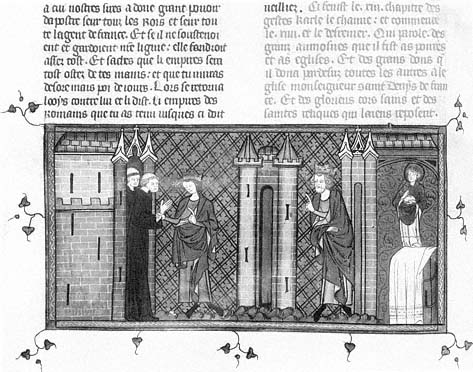
Figure 31
Charles the Bald presents gifts to Saint-Denis. Grandes Chroniques de France .
British Library, Royal 16 G VI, fol. 235v. By permission of the British Library.
the monks, as Ste.-Gen. 782 had been to Philip III, it is doubtful that such imagery would have been included.
If we reject Delisle's theory that Charles V's chancellor directed the revision of this Grandes Chroniques , then the London chronicle takes its rightful place as an important example of John's literary patronage. Following the lead of his mother, Jeanne of Burgundy, John the Good commissioned numerous translations of religious books and politically oriented texts, many of which were densely illustrated.[19] The Grandes Chroniques surviving in the British Library may well be one of the earliest of these commissions.
Pictures are integral parts of John's Grandes Chroniques . Almost every chapter has a miniature; 418 illustrations contain over 600 scenes. Curiously, this wealth of imagery has never been fully examined, despite its significant difference from all other royal copies of the chronicle. This neglect may be the result of John's image as a chevalier who loved the hunt, relished battle, and lived luxuriously,[20] a view that colored certain interpretations of his manuscript and led scholars to dismiss its pictures as derivative. Stiennon and Lejeune, for example, concluded that the
manuscript derived its cycle of Roland from chansons de geste[21] and that its pictures did not even illustrate the chronicle. Historians of art have therefore restricted their analyses of this book to studies of style.[22]
Yet the illustrative cycle of John's Grandes Chroniques is never purely derivative but creatively modifies its sources, as demonstrated in its relation to Philip III's chronicle (Ste.-Gen. 782), which, as the only other copy of the text known to have been in the royal library, may have been a source, and to a historical and hagiographic text also preserved in the royal library, the Vita et Passio Sancti Dionysii of Ivo of Saint-Denis.
If the compiler of John's Grandes Chroniques consulted Philip III's book, he adapted only certain aspects of its pictorial layout. For example, in both royal manuscripts the lives of the imperial Carolingians (Charlemagne, Louis the Pious, and Charles the Bald) are more densely illustrated than other royal lives. Philip's manuscript, however, places great emphasis on the imperial Carolingians, thus associating Philip Augustus with the early Carolingians—particularly with Charlemagne—as royal models for Philip III. John's Grandes Chroniques , on the other hand, does not involve the imperial Carolingians in a system of sophisticated pictorial cross-references but simply illustrates their texts and, through variations in scale and density, emphasizes themes already present in the chronicle. Most of the numerous illustrations to the lives of Charlemagne, Louis the Pious, and Charles the Bald in John's chronicle concentrate on themes that provide appropriate models for his kingship: Charlemagne's military prowess and his piety. The fact that John took part in battle from an early age might explain why the seven pictures (fols. 141v, 143, 144, 145v, 147, 148v, and 149v) illustrating Charlemagne's campaigns in the second book of his life are two columns wide. Charlemagne's piety is a less common theme for a prince's book; nonetheless, John's manuscript contains a pair of double miniatures followed by a series of seven scenes in which Charlemagne in Constantinople receives the relics of Christ's suffering (fols. 159, 160), brings the relics home (fol. 161v), witnesses their miraculous properties (fol. 162v), and displays them to the populace at the fair of Lendit (fol. 163). Indeed, Charlemagne's recovery and adoration of Christ's relics are given more emphasis than the crusade by which they were acquired. Such an unusual combination of military prowess and religious devotion was doubtless intended to demonstrate the desired balance between worship and action in a Christian king.
The admonitions added to the text to look for more information in the lives of the saints were taken to heart in its program of illustrations. The pictures of John's Grandes Chroniques blend images drawn from a variety of hagiographic traditions into an integrated cycle that closely illustrates its text. For example, one particularly dense subcycle in the Grandes Chroniques relates to an illustrated saint's life preserved in both the Dionysian and royal libraries: the Vita et Passio Sancti Dionysii by Ivo of Saint-Denis.[23]
Ivo of Saint-Denis's history, the third portion of the Vita et Passio , begins with the fall of Troy and ends in the reign of Philip V. Even though its structure, like that of the Grandes Chroniques , follows a sequence of royal biographies, its content focuses on the role in French history of Saint Denis and the abbey that bears his name. Predictably, one of the fullest royal cycles in Ivo's historical
compilation illustrates the life of Dagobert, the royal founder of the abbey of Saint-Denis.
Dagobert's life is also the most densely illuminated of the Merovingian kings in John's Grandes Chroniques ; five 2-column miniatures are among 14 pictures dedicated exclusively to Dagobert. The iconography and style of this cycle are closely related to those of a contemporary copy of Ivo's text (B.N. lat. 5286), the only surviving witness to the full cycle of illustration in Ivo's presentation copy and a reliable guide to its cycle of illustrations. The pictorial model of Ivo's history is, however, transformed in John's book in order to concentrate on French kingship.[24]
A comparison of images from the Grandes Chroniques with equivalent scenes from the Vita et Passio demonstrates how carefully the pictures in John's chronicle were selected. The Vita et Passio includes six full-page miniatures, read left to
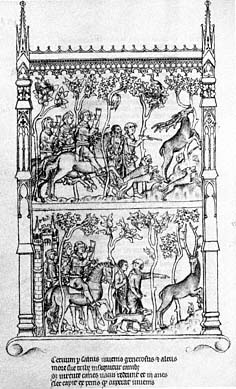
Figure 32
Sighting and pursuit of stag. Ivo of Saint-
Denis, Vita et Passio Sancti Dionysii .
Bibliothèque Nationale, Ms. lat. 5286, fol.
135v. Photograph: Bibliothèque Nationale, Paris.
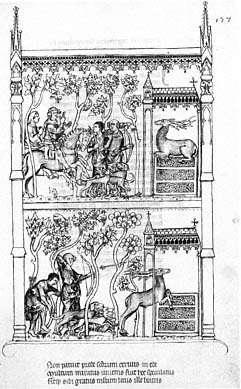
Figure 33
Stag takes refuge in Saint-Denis. Ivo of
Saint-Denis, Vita et Passio Sancti Dionysii .
Bibliothèque Nationale, Ms. lat. 5286, fol. 137.
Photograph: Bibliothèque Nationale, Paris.
right and bottom to top, that illustrate the discovery of the tomb of Saint Denis by Dagobert. The sighting and pursuit of the stag, complete with the hunters blowing horns in the first miniature (Fig. 32), is a separate image from the second, the stag's entry into the church containing the tomb of Saint Denis from which Dagobert and his fellow hunters were miraculously excluded (Fig. 33). Two subsequent miniatures show why Dagobert needed to seek refuge at the tomb. In the third, Dagobert's tutor insults him, and Dagobert humiliates his tutor as a punishment (Fig. 34). In the fourth, the tutor appeals to King Clotaire for revenge, Dagobert seeks sanctuary at the tomb from his father's wrath, and soldiers are sent to bring him back for punishment (Fig. 35). In the Dionysian manuscript of the Vita et Passio the king does not go to the tomb until his emissaries have failed to gain entry. The flurry of activity in this sequence of illustrations to Ivo's history centers on the tomb, which is also the central focus of the tale.
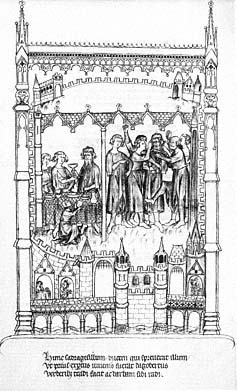
Figure 34
Dagobert tests and punishes his tutor.
Ivo of Saint-Denis, Vita et Passio Sancti
Dionysii . Bibliothèque Nationale,
Ms. lat. 5286, fol. 138v.
Photograph: Bibliothèque Nationale, Paris.
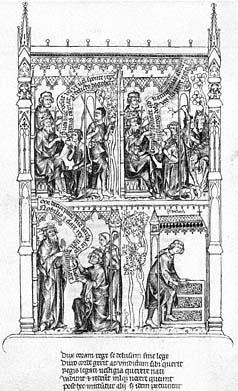
Figure 35
The tutor demands revenge; Dagobert
seeks sanctuary at Saint-Denis. Ivo of
Saint-Denis, Vita et Passio Sancti Dionysii .
Bibliothèque Nationale, Ms. lat. 5286, fol.
139v.
Photograph: Bibliothèque Nationale, Paris.
The story concludes when Saint Denis and his companions appear to Dagobert who, inspired by them, writes to his father (Fig. 36) and is reconciled to him (Fig. 37).
Although all the events pictured in Ivo's history are described by the text of the Grandes Chroniques , the miniatures in the chronicle are concerned less with the tomb than with Dagobert's miraculous protection by Saint Denis; extraneous details of the hunt are omitted. Dagobert's discovery of the tomb of Saint Denis and his companions is the focus of only two large miniatures in John's Grandes Chroniques . The first (Fig. 38) combines the chase after the stag with the frustration of the hunters when they cannot reach their quarry because Saint Denis protects it. The second image (Fig. 39) illustrates how Dagobert takes advantage of Saint Denis's protection after he has humiliated his tutor and
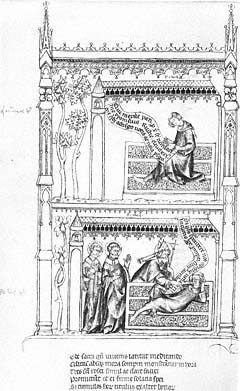
Figure 36
Saint Denis and companions appear to
Dagobert; Dagobert writes to his father.
Ivo of Saint-Denis, Vita et Passio Sancti
Dionysii . Bibliothèque Nationale, Ms.
lat. 5286, fol. 140v.
Photograph: Bibliothèque Nationale, Paris.
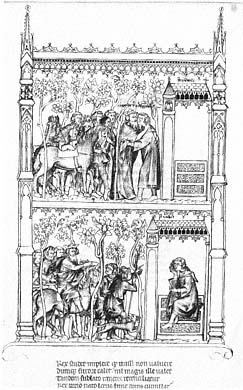
Figure 37
Dagobert reconciled with King Clotaire.
Ivo of Saint-Denis, Vita et Passio Sancti
Dionysii . Bibliothèque Nationale, Ms. lat.
5286, fol. 141v.
Photograph: Bibliothèque Nationale, Paris.
sought sanctuary from his father's wrath in the place where the stag has been protected.
The pictures in the Grandes Chroniques also emphasize Dagobert's relationship with his father, the king. Unlike Ivo's Vita et Passio (Fig. 35), the Grandes Chroniques portrays King Clotaire accompanying the messenger (Fig. 39), even though a small minature illustrating Dagobert's vision and his reconciliation with Clotaire (Fig. 40) appears later in the correct narrative sequence. By stressing King Clotaire's exclusion from his son's refuge, John's chronicle shifts the focus away from Saint Denis's tomb—the center of attention in Ivo's Dionysian text—to the royal story, the relation between father and son.
As this small portion of the cycle of Dagobert's life demonstrates, the illustrative program of this Grandes Chroniques is independent of contemporary iconographical sources. The pictures of Dagobert's life are not simply quotations from preexisting, mainly Dionysian, cycles. They are free adaptations designed to focus attention on Dagobert. Indeed, the parallel scenes of Dagobert's hunt and sanctuary in the Grandes Chroniques are two of only five large scenes among the 14 minatures that illustrate his life. They are given large scale as an important early manifestation of Dagobert's special status, just as the last large miniature, in which Dagobert establishes his testament in conference (fol. 107), demonstrates the full fruition of his kingly wisdom as he provides for his succession.
Numerous other sources for the illustrations of John the Good's Grande Chroniques probably exist; Stiennon and Lejeune imply parallels with the
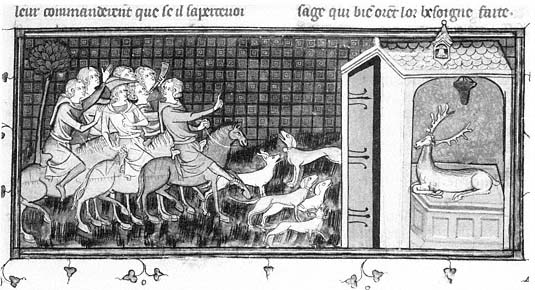
Figure 38
Hunt of the stag. Grandes Chroniques de France . British Library, Royal 16 G VI, fol. 92.
By permission of the British Library.
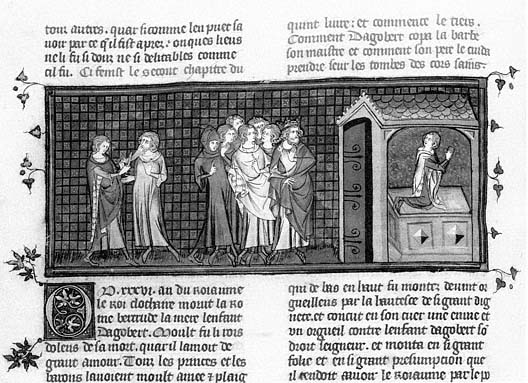
Figure 39
Dagobert in sanctuary. Grandes Chroniques de France . British Library, Royal 16 G VI, fol. 93v.
By permission of the British Library.
illustration of romances, although this has not yet been proven.[25] Despite its numerous sources, however, John's chronicle is a carefully constructed whole in which the densest cycle of pictures to appear in any manuscript of the Grandes Chroniques complements a thoroughly revised and glossed text. Derivative or not, the pictures were selected to work with their text in a program of decoration, and they are best understood in that context.
Interpretations that concentrate solely on visual or textual sources for the imagery of John the Good's book fail to account for either the internal structure of the manuscript or the close relationship between the text of the chronicle and its 418 minatures. The pictorial structure of the book is not tightly woven, but multiple miniatures introduce and subdivide chapters to stress certain distinctive themes,[26] suggesting that certain portions of the text had special importance for John the Good. The lives of Charlemagne, Louis the Pious, and Charles the Bald—the imperial Carolingians—contain an especially dense concentration of illustrations; 77 of 97 miniatures in this portion of the chronicle are two columns wide, as compared to 126 of 321 in the rest of the book. Occasional clusters of two-column miniatures also occur in the lives of Clovis, Dagobert, and Charles
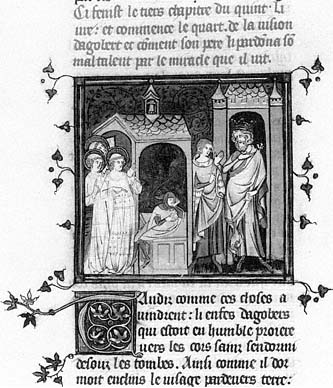
Figure 40
Dagobert's vision and reconciliation with
Clotaire. Grandes Chroniques de France .
British Library, Royal 16 G VI, fol. 94v.
By permission of the British Library.
Martel. Crusading imagery and the representation of relics are carefully detailed in pictures that may have been timely responses to contemporary politics. If there is one overarching theme in the cycle as a whole, however, it is the celebration of France's God-given kingship, whose holy character was confirmed by the sainthood of Louis IX.
Politics and the Problem of Succession
The illustration to the prologue and the changes to its text establish the theme of succession as central to John the Good's Grandes Chroniques . The prologue's miniature (Plate 1) is a nonnarrative image showing the coronation of an enthroned pagan king of France flanked by a pagan duke and two Christian rulers. Their costumes identify them: the duke wears a circlet, and the kings wear crowns adorned with fleurons; checkered patterns mark the robes of pagan rulers, and the fleur-de-lis, given to the French during the reign of Clovis, the first Christian king, distinguishes Christian rulers.
The pagan duke stands on a pedestal to the left of the enthroned king, and the Christian kings stand on pedestals to the right. This arrangement suggests that they should be interpreted as the predecessor and successors of the king whose coronation is taking place. If this is the case, then the sequence of pagan duke to pagan king to Christian kings identifies the coronation as that of Pharamond, the first king of France.
To an audience familiar with the court, as readers of this royal manuscript would have been, this miniature must have recalled the sequence of sculpted kings, beginning with Pharamond, that decorated the Grande Salle of the royal palace. A change in the prologue reinforces the pictorial reference. Just after the description of the three lines of kings who governed France, John's chronicle modifies the phrase in the prologue, "The beginning of this history will be taken at the noble line of the Trojans from whom it [the French line] is descended by long succession," to read "is descended by succession of time."[27] Neither picture nor text places undue stress on the relationship of these rulers by blood. Both seem to celebrate instead the continuity of the office of king, to which the king is elected and in which he is supported by the barons who help place the crown on his head in the miniature.
These changes in image and text may have been timely responses to the difficulties created by the succession of the early Valois kings. In the late 1330s, when this Grandes Chroniques was produced, Edward III was the main threat to John the Good, claiming the French throne and waging campaigns against the French in propaganda and on the battlefield. Edward's claim, supported by his political and military maneuvers, helps to clarify the imagery of the introductory miniature and to reveal its relation to its text and perhaps to the rest of the cycle.
Edward's anti-Valois propaganda, which centered on John, the heir apparent, rather than his father, Philip, the first Valois king,[28] may well have begun before Edward claimed the kingship of France in 1337. As early as 1332 Philip anticipated a difficult succession and had his barons swear to support John should Philip die while on crusade. John's need for protection lasted through the 1340s; in 1347 his brother-in-law, Charles IV, the Holy Roman Emperor, promised to aid John if his succession were threatened.
In 1340 Edward's agents disseminated a poster containing a French translation of the Latin letter in which Edward claimed to be the legitimate heir to Charles IV, the last Capetian, who died in 1328, and assumed the royal style of King of France and England.[29] This translated letter, posted on church doors in northern France, was so inflammatory that Philip ordered all copies confiscated and all who posted it or permitted it to be posted imprisoned.
Edward's propaganda was so broadly disseminated that it affected the visions recorded in the late 1340s by Saint Bridget of Sweden,[30] an anti-French author often quoted by the English in their political writings. In one vision the Virgin Mary appeared to Bridget and contended that Philip was a legitimate king, since he had been selected by the barons of France and had not come to the throne by violence,[31] and should therefore rule France until his death. Many asserted, however, that Edward was closer to the inheritance of the throne than Philip and should be designated by Philip as his successor.[32]
Such threats to John's legitimacy may explain why the prologue and its miniature present succession to the throne as a "succession of time" rather than
a succession of blood. Such an argument could be used to defuse English claims. Other portions of the cycle focus on the same themes as Edward's propaganda, celebrating descent from Saint Louis and the idea of a crusade, while promoting France's holy kingship.
Saint Louis:
The Model Roi Très Crétien
Almost from the moment of his death, Louis IX became a model for royal behavior against whom subsequent kings were measured and often found wanting. Royal descent from Louis cut in two directions; while the canonization of a French king gave the Capetians proof that they were part of a line of rois très crétiens , Louis's life was a reproach to subsequent kings who, not gifted with sanctity, had difficulty living up to his example.[33] Nonetheless, devotion to the royal saint was strong, particularly among members of the royal house. Such patrons as Louis's daughter, Blanche; his wife, Marguerite; his grandson, Philip IV; Jeanne de Navarre; and Jeanne d'Evreux commissioned portraits of Saint Louis and cycles of his life in panel paintings, frescoes, stained glass, and manuscripts.[34] These cycles celebrated Louis IX's sanctity and the special status of the Capetians who were related to the saint.
Saint Louis played an important role in polemical discussion from the moment Philip of Valois succeeded the last direct Capetian. Philip viewed himself as the head of the Capetian house and often used references to Saint Louis, particularly during the first troubled years of his reign, to add the prestige of his royal ancestor to his own acts.[35] He ordered coinage early in his reign "of the weight and law of Saint Louis" and refrained from doctoring its composition until 1337 because of the value of its symbolic connection.[36] Between 1329 and 1331 a series of documents issued by Philip's chancery adopted the form employed by the Capetians, opening with an invocation and closing with the royal monogram and signatures of court officials. Cazelles notes that this literary form was abandoned as soon as Edward III confirmed the legitimacy of the Valois succession by acknowledging in 1331 that his homage of 1328 to the French should have been liege.[37]
While Edward continued to claim the throne of France, however, he celebrated his own descent from Saint Louis. In the 1340 letter posted in northern French churches, he stressed that he did not want to infringe on the rights of the French people, but rather he wanted to return France to the "good laws and customs which existed in the time of our ancestor [and] progenitor Saint Louis, king of France."[38] He also emphasized the need for peace in Christian countries so that a crusade could be mounted to free the Holy Land.[39] The notion of a unified crusade of the Western nations was a recurring theme that became intertwined toward the end of the Hundred Years' War with prophecies of the last world emperor.[40] When Edward's letter was written and John's book painted, however, the references to a crusade probably related more closely to claims of direct descent from Saint Louis, the last crusading king of France, rather than to claims to world empire. They refer as well to the legitimate French king's status as "most Christian king."
The crusading reference in Edward's letter was probably a jibe at Philip and John. As early as 1334 Philip, who had vowed to go on crusade, sent the
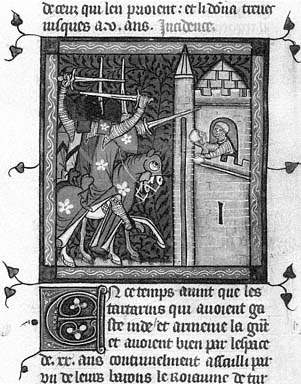
Figure 41
Assault on a castle by the Tartars. Grandes
Chroniques de France . British Library, Royal 16 G
VI, fol. 400. By permission of the British Library.
Connétable d'Eu to England to persuade Edward III to participate in the crusade that Philip had negotiated with Pope John XXII.[41] With the approval of the pope, Philip collected special ecclesiastical taxes but did not go to the Holy Land because of France's uncertain relations with England; instead, from 1335 to 1337 Philip used the funds to finance his English war.[42] In March of 1340, a little over a month after Edward's letter was written, Philip asked Pope Benedict XII for a pardon for his fiscal indiscretion. Only in 1344 was the pardon awarded by Pope Clement VI to Philip and to John, who apparently shared responsibility for this fiscal abuse.
It is tempting to see the emphasis on crusades in John the Good's Grandes Chroniques (1335–40), particularly crusades in which Saint Louis participated, as reflecting the French side in the polemical war with England. Louis's crusades receive special attention in the dense cycle that illustrates John's manuscript: only six pictures in the entire manuscript subdivide chapters, and three of these occur in the crusading sections of Saint Louis's life.[43] These miniatures establish each of Louis's crusades as a holy war, provoked by pagans. The first two illustrate Louis's first crusade: one represents the dastardly behavior of the infidels (Fig. 41, assault on a castle by the Tartars); the second represents the response of the Christians (Fig. 42, the pope sends Bishop Odo to Paris; nobles listen to Bishop Odo
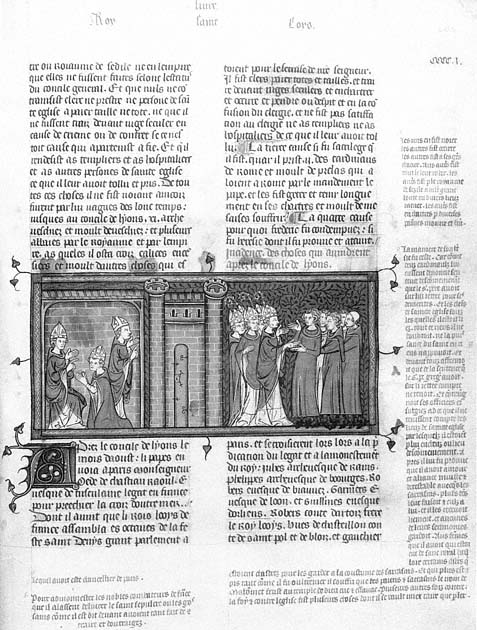
Figure 42
Pope sends Bishop Odo to Paris; Nobles take the cross. Grandes Chroniques de
France . British Library, Royal 16 G VI, fol. 403. By permission of the British Library.
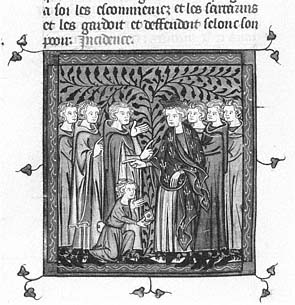
Figure 43
Louis receives a letter about the Holy Land.
Grandes Chroniques de France . British Library,
Royal 16 G VI, fol. 426v.
By permission of the British Library.
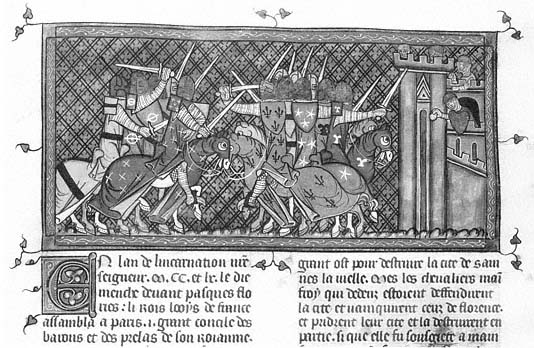
Figure 44
Attack of the Tartars in the Holy Land. Grandes Chroniques de France . British Library, Royal 16 G
VI, fol. 427. By permission of the British Library.
and take the cross). In the third subdivision in Louis's life a pair of miniatures explains why the French became involved in Louis's second crusade, in which he died. They illustrate the arrival of a letter from the pope and then represent its contents describing attacks by the infidels (Fig. 43, Charles of Anjou in council receives a letter from the pope; Fig. 44, attack of the Tartars in the Holy Land).
Aside from miniatures whose subjects can be classed as administrative (receptions of envoys and meetings with various heads of state; fols. 403v, 405, 406, 407, 407v, 408v), all other pictures of Louis's crusades bring out two themes: his victories in the Holy Land and his sanctity. Miniatures of Louis's triumphs in his first crusade show the battle and capture of Damietta (409v, 410v), but his religious devotion attracts more emphasis in such scenes as the pilgrimage to Nazareth (fol. 415v) or the burial of the dead after the massacre at Sidon (fol. 416v). The miniatures illustrating Louis's second crusade celebrate his sainthood more emphatically. Louis is nimbed throughout this final sequence of 10 pictures, which culminates with his instructions to his son (fol. 443v) and his death (Fig. 45).
In keeping with French policy of the 1330s and 1340s, this emphasis on Louis IX's life is less a call to a crusade than a celebration of the saintly king from whom John was descended and of the holy kingship to which John was
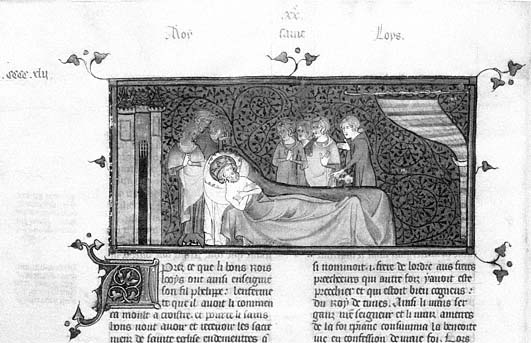
Figure 45
Death of Saint Louis. Grandes Chroniques de France . British Library, Royal 16 G VI, fol. 444v.
By permission of the British Library.
heir. The possibility that this celebration of descent from Louis IX may have had an anti-English component is strengthened by John's choice in 1350 to be crowned with the "crown of Saint Louis" rather than that of Charlemagne. This act was simultaneously a sign of his devotion to the saint and an affirmation of his legitimacy as successor to Saint Louis and to Philip of Valois.[44]
The Prerogatives of Holy Kingship
Two sets of images in John the Good's copy of the Grandes Chroniques introduce themes that were to become particularly important in the reigns of John and later Valois kings. Images in the life of Clovis refer to the sacre by the holy oil sent from God, and a rare picture in the life of Saint Louis refers to the king's role in the cure for scrofula. Both represent privileges that the French king claimed as the roi très crétien .
The right to be anointed with special oil sent from heaven distinguished the French ruler from all other rulers in Christendom and made him the equal, if not the superior, of the Holy Roman Emperor.[45] This right, which originated in the reign of Clovis, the first Christian king of France, is the subject of two large miniatures in John's chronicle. In the first (Fig. 46) Clovis routs the Germans under the protection of Christ, who gazes down at the battle.[46] The text explains that Clovis won this battle because he vowed to convert if given a victory. In the second large miniature (Fig. 47) Clovis is baptized by the holy oil brought by a dove. The only other large illustration (Fig. 48) in Clovis's life involves another miraculous sign from God. In it, messengers sent to the church of Saint Martin at Tours to ask for a sign of victory were greeted as they entered by the psalm, "Sire thou did gird me with strength for the battle. . . . Thou did make my assailants sink under me."[47] All three of these distinctive pictures celebrate the French kings' close relationship to God.
The holiness of Saint Louis's kingship is emphasized by the use of halos that focus particular attention on two sequences from the cycle of 60 pictures illustrating his life. This practice seems deliberate, since the halos have no discernible structural or textual function in these portions of the manuscript. It does not seem to be an artistic trait, since the two artists who painted these sequences did not use halos in other portions of Louis's life that they painted. Neither is it a case of mixing models from varied sources, since the scenes in which Louis wears a halo do not break down into iconographical units whose models could be isolated.
The most densely illustrated sequence begins when Louis takes the cross to go on his second crusade (fol. 436v); it continues through the series of 10 pictures that show the events that led to Louis's death in Tunis. In this sequence halos draw attention to a crusading subcycle that culminates in Louis's saintly death (Fig. 45).
The use of halos elsewhere in Louis's life is more puzzling. Only two from a series of scenes dedicated to his saintly behavior represent Saint Louis wearing a halo: Louis attending confession and being scourged by his confessor (Fig. 49), and Louis feeding the poor (fol. 423v). Ordinarily the authority of the pictorial model or peculiarities of the artist explain such intrusions, but such is not the case here. One artist painted the whole sequence of scenes dealing with Louis's
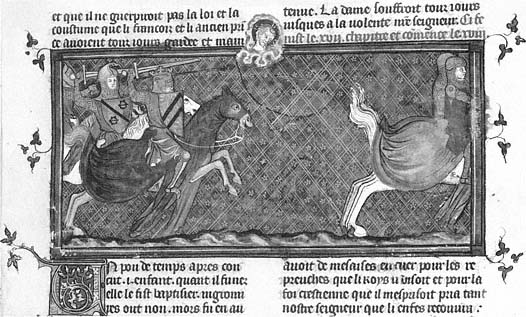
Figure 46
Clovis routs the Germans. Grandes Chroniques de France . British Library, Royal 16 G VI, fol. 15.
By permission of the British Library.
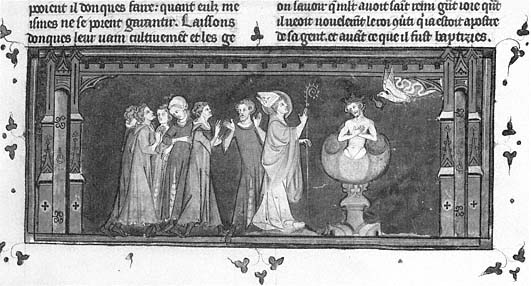
Figure 47
Baptism of Clovis. Grandes Chroniques de France . British Library, Royal 16 G VI, fol. 16.
By permission of the British Library.
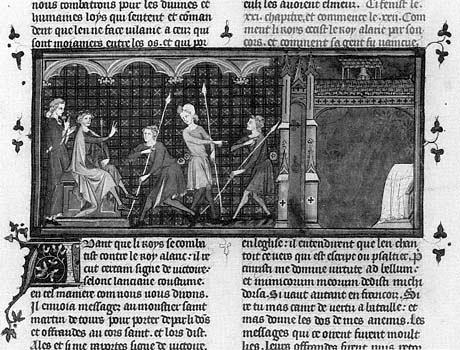
Figure 48
Miracle at Saint-Martin of Tours. Grandes Chroniques de France . British Library,
Royal 16 G VI, fol. 18. By permission of the British Library.
holiness, and the two images in which Louis wears a halo do not constitute a distinct subcycle.
The best explanation for this phenomenon derives from the relationship of this sequence of miniatures to its text and to the illustrations that precede and follow it. The two pictures precede a miniature (Fig. 50) that occurs in no other copy of the Grandes Chroniques and, to my knowledge, in no manuscript predating the reign of Charles VII.[48] It represents a special prerogative given the French kings after their unction with the holy oil: the ability to cure scrofula, the disease known as "the king's evil." The picture shows Louis IX speaking as he touches the neck of a man who kneels before him; the text emphasizes Louis's devotion by describing how he introduced the sign of the cross into the ritual in order to minimize his own agency in the cure: "King Louis had the custom that while saying the words [of the ritual] he always made the sign of the cross which by the virtue of Our Lord cures the sick more than the royal dignity."[49] It is therefore likely that Louis was given a halo in the two previous scenes to reinforce God's role rather than his own in the third scene. A reader turning the pages in sequence would be struck by the lack of a halo in the picture of the cure for scrofula. The image would reinforce the textual reference to the role of Christ, rather than the king, in effecting the cure. One of the marginal glosses attests to the continued importance of this point at the time that John's manuscript was annotated: "Why
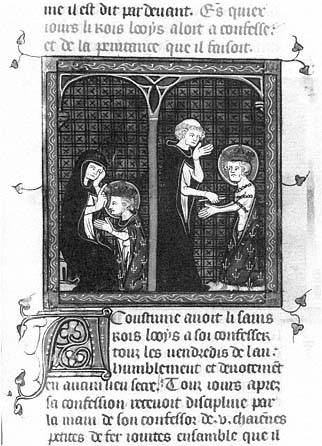
Figure 49
Louis IX at confession; Louis disciplined by his confessor.
Grandes Chroniques de France . British Library, Royal 16 G
VI, fol. 423. By permission of the British Library.
he [Saint Louis] attributes this virtue to the sign of the cross and not to the royal dignity."[50]
This celebration of Louis's miraculous powers as king emphasizes his devotion and humility, but it also has political significance, for the ability of the French kings to cure the "king's evil" was being challenged for the first time. Throughout most of the fourteenth century, the ability of the French and English kings to perform miraculous healing had been accepted as fact and as a gift shared equally by both monarchies.[51] During the Hundred Years' War, however, the ability to cure may have become a sign of legitimacy. In the late 1340s a Frenchman was imprisoned for six years because he asserted that the king of England should be king of France because he cured scrofula better.[52]
Perhaps because of the shaky political situation that existed in France, John the Good's Grandes Chroniques de France differs markedly from the book in the royal library that should logically have been its model: Philip III's Grandes
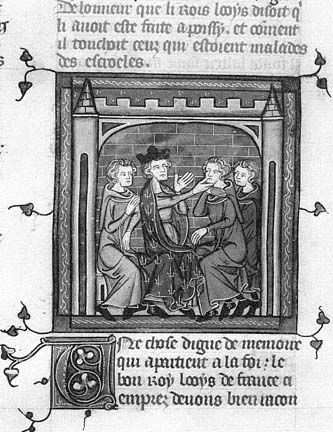
Figure 50
Cure of scrofula. Grandes Chroniques de France . British
Library, Royal 16 G VI, fol. 424v.
By permission of the British Library.
Chroniques (Ste.-Gen. 782). Philip III's manuscript was commissioned for him by the monks of Saint-Denis during a time of peaceful succession to the throne. Its text celebrates the royal line descended from Troy and the role of the abbey of Saint-Denis in French history. The pictures reinforce these themes in a program of just 36 images that illustrate their own texts carefully, but also establish visual cross-references intended to provide specific models of government for Philip.
The circumstances under which John's book was produced affected its content and appearance. Elements of its text and pictorial cycle suggest that it originated in the Parisian court rather than the Dionysian abbey. Its pictures support this interpretation, for their density is analogous to other commissions of John the Good and their form reflects contemporary styles in romances and saints' lives. These pictures function differently from those in Philip III's Grandes Chroniques . Although the 600 scenes relate to their texts as closely as the pictures in the earlier chronicle, the density of the cycle in John's manuscript, which illustrates almost
every chapter of the text, made it impossible to implement the kind of cross-referencing that structures Philip III's book. Instead, the book's designer sought to break up the sequence of pictures by employing variations in scale and by playing on the presence or absence of such iconographic details as halos. Several images featured in this way focus the reader's attention on themes of Christian kingship, particularly on those that would bolster John's shaky position within the new Valois line vis-à-vis his English competitor.